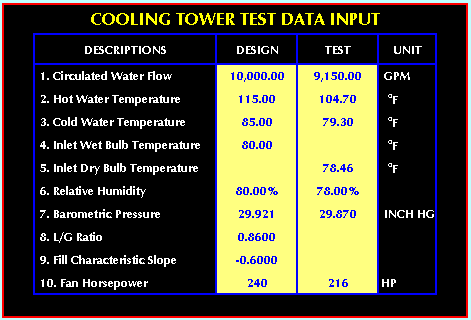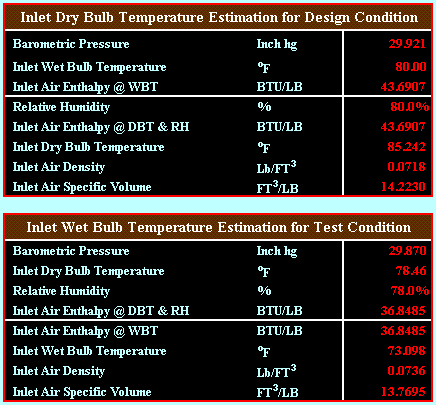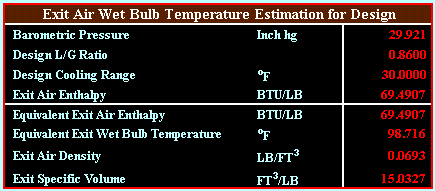|
|
|
|
|
KaV/L = C L/G-m C and m are constant for a given cooling tower and are determined by the characteristics of the fill, while m is determined by end effects. The characteristic curve is used in conjunction with a KaV/L vs L/G relationship to determine performance. This curve may be termed "Design requirement" curve, since it is a measure of the degree of difficult of the design requirements, and has nothing to to with the physical characteristics of the tower. It is constructed by assuming values of L/G and computing the corresponding values of KaV/L using the following equations.
where, hw is the enthalpy of air-water vapor mixture at the bulk water temperature and ha is the enthalpy of air-water vapor mixture at the equilibrium wet bulb temperature. The intersection of the characteristic and design requirements curves locates the design point. The manufacturer predicts that, when operating at the L/G value so located and at design water circulation rate, inlet water temperature, and wet bulb temperature, design outlet water temperature will be attained. The test value of L/G is determined from Eq. 22-1, 22-10 & 22-12 which were derived in the chapter 22. From these equations, L/G dsn is the L/G value at the intersection of the characteristic and design requirement curves. The corresponding value of KaV/L is computed from above Eq. 63-1 using the test wet bulb and water temperatures. This point is then plotted, and a line a parallel to the characteristic curve is drawn through it. The intersection of this line and design requirements curve locates the L/G capability at the design conditions. Example 21-1: Determine the tower capability using the characteristic curve for the initial design conditions and below test records.
(Solution)
Exit Enthalpy @ Design = Inlet Enthalpy @ Design + L/G design x Range @ Design = 43.6907 + 0.8600 x (115 - 85) = 67.4907 BTU/LB
Exit Enthalpy @ Test = Inlet Enthalpy @ Test + L/G test x Range @ Test The L/G test is calculated from the below formula. L/G test = L/G design x (Water Flow test / Water Flow design) x (Fan BHP design / Fan BHP test)1/3 x (Exit Air Density test / Exit Air Density design)1/3 x (Exit Air Specific Volume test / Exit Air Specific Volume design) Derivation details of L/G Test are as below:
Then, above equation could be expressed to Constant = Fan BHP / (VOL3 x Density). Therefore, the following relationship is established. Constant = BHP dsn / (VOL
dsn3 x Density dsn) = BHP test / (VOL test3
x Density test)
Then,
|








